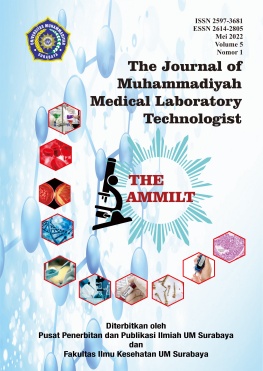Isi Artikel Utama
Abstrak
As technology develops, air quality tends to decline. One of the air pollutants that is often encountered is bacteria that infect through the air such as Staphylococcus aureus. As a basic protection tool, a cloth mask with a membrane layer can be an alternative solution. One of the materials that can be used is chitosan and lime peel pectin. Lime peel produces essential oils that are used as stimulant, aromatherapy, and antimicrobial enhancers. This study aims to determine the results of characteristic tests, content analysis through phytochemicals and Staphylococcus aureus. The research method used is descriptive exploratory and experimental. The membrane mask made from chitosan of shrimp skin and lime peel has a characteristic thickness of 00.24 mm with a density of 0.60 - 0.90 g/cm3 with a textured heterogeneous surface. Has a water vapor transmission power of 0.00088 g/day/m2. It takes 27.54 days to completely decompose. Grapefruit peel essential oil contains secondary metabolites in the form of alkaloids, flavonoids, tannins, phenolics and triterpenoids. The membrane mask had Staphylococcus aureus antibacterial activity ranging from 14.05 mm.
Â
Keywords: Lime peel (Citrus aurantiifolia), Shrimp Skin Chitosan, Membrane mask, Antibacterial.
Rincian Artikel
Referensi
- 1. Agusnar, H., 2006. Penggunaan Glutaraldehid Kitosan Untuk Penurunan Konsentrasi Ion Logam Ni2+ dan Cr3+ Menggunakan Ekstraksi Fasa Padat. (Disertasi). Medan: USU. 2020.09.15.
- Ayuni, Ni Putu Sri., Dwi Siswanta., Adhitasari Suratman. 2014. Sintesis Dan Karakterisasi Membran Kompleks Polielektrolit (Pec) Kitosan-Pektin. https://ejournal.undiksha. ac.id/index.php/semnasmipa/article/v iew/10498
- Bota, W. 2015. Potensi Senyawa Minyak Sereh Wangi (Citronella oil) dari Tumbuhan Cymbopogon nardussebagai Agen Antibakteri. Jurnal Fakultas Teknik Universitas Muhammadiyah Jakarta. [23 September 2020].
- Ergina. Siti, N. Indarini, D. P. 2014. Uji Kualitatif Senyawa Metabolit Sekunder Pada Daun Palado (Agave angustifolia) Yang Diekstraksi Dengan Pelarut Air Dan Etano. J. Akad. Kim. Vol 3(3): hal 165-172.
- Ernawati. & K. Sari. 2015. Kandungan Senyawa Kimia Dan Aktivitas Antibakteri Ekstrak Kulit Buah Alpukat (Persea americana P.Mill) Terhadap Bakteri Vibrio Alginolyticus. Jurnal Kajian Veteriner. Vol. 3(2): hal 203-211.
- Hidayah, Nurul., Hasrida Mustafa., Murni., Intan Tolistiawaty. 2018. Efektivitas Repelan Losion Minyak Atsiri Kulit Jeruk Bali (Citrus maxima (Burm.) Merr.) terhadap Aedes aegypti.Jurnal Visikes. Vol.10, No.2, 2011: 131- 137.
- Isnaini. 2015. Pengaruh konsentrasi kitosan terhadap aktivitas antibakteri dengan metode difusi agar (sumur). Jurnal Teknoloogi Industri dan Hasil Pertanian 13(2): 117- 125.
- Kowalonek. 2017. Studies of chitosan/pectin complexes exposed to UV radiation. https://www.sciencedirect.com/science/article/abs/pii/S01418130173051 0X.
- Rijayanti R. P. 2014. Uji Aktivitas Antibakteri Ekstrak Etanol Daun Mangga Bacang (Mangifera indica L) terhadap Staphylococcus aureus secara in vitro. Disertasi. Fakultas Kedokteran Universitas Tanjungura. Pontianak.
- Roikah, Sri., Wara Dyah Pita Rengga., Latifah., Ella Kusumastuti. 2016. Ekstraksi dan Karakterisasi Pektin Dari Belimbing Wuluh (Averrhoa bilimbi,L). https://media.neliti.com/media/publi cations/74293.
- Safitri, Isna, Medyan Riza, dan Syaubari. 2016. Uji Mekanik Plastik Biodegradable Dari Pati Sagu Dan Grafting Poly (Nipam) -Kitosan Dengan Penambahan Minyak Kayu Manis (Cinnamomum burmannii) Sebagai Antioksidan. Jurnal Litbang Industri Vol. 6 No. 2, Desember 2016: 107-116.
- Savitri, Tania. 2020. Bagaimana Bakteri Bisa Menyebar dan Menyebabkan Penyakit?. https://hellosehat.com/hidupsehat/fakta-unik/proses-penyebaranbakteri-adalah/. [15 Juni 2021]
Referensi
1. Agusnar, H., 2006. Penggunaan Glutaraldehid Kitosan Untuk Penurunan Konsentrasi Ion Logam Ni2+ dan Cr3+ Menggunakan Ekstraksi Fasa Padat. (Disertasi). Medan: USU. 2020.09.15.
Ayuni, Ni Putu Sri., Dwi Siswanta., Adhitasari Suratman. 2014. Sintesis Dan Karakterisasi Membran Kompleks Polielektrolit (Pec) Kitosan-Pektin. https://ejournal.undiksha. ac.id/index.php/semnasmipa/article/v iew/10498
Bota, W. 2015. Potensi Senyawa Minyak Sereh Wangi (Citronella oil) dari Tumbuhan Cymbopogon nardussebagai Agen Antibakteri. Jurnal Fakultas Teknik Universitas Muhammadiyah Jakarta. [23 September 2020].
Ergina. Siti, N. Indarini, D. P. 2014. Uji Kualitatif Senyawa Metabolit Sekunder Pada Daun Palado (Agave angustifolia) Yang Diekstraksi Dengan Pelarut Air Dan Etano. J. Akad. Kim. Vol 3(3): hal 165-172.
Ernawati. & K. Sari. 2015. Kandungan Senyawa Kimia Dan Aktivitas Antibakteri Ekstrak Kulit Buah Alpukat (Persea americana P.Mill) Terhadap Bakteri Vibrio Alginolyticus. Jurnal Kajian Veteriner. Vol. 3(2): hal 203-211.
Hidayah, Nurul., Hasrida Mustafa., Murni., Intan Tolistiawaty. 2018. Efektivitas Repelan Losion Minyak Atsiri Kulit Jeruk Bali (Citrus maxima (Burm.) Merr.) terhadap Aedes aegypti.Jurnal Visikes. Vol.10, No.2, 2011: 131- 137.
Isnaini. 2015. Pengaruh konsentrasi kitosan terhadap aktivitas antibakteri dengan metode difusi agar (sumur). Jurnal Teknoloogi Industri dan Hasil Pertanian 13(2): 117- 125.
Kowalonek. 2017. Studies of chitosan/pectin complexes exposed to UV radiation. https://www.sciencedirect.com/science/article/abs/pii/S01418130173051 0X.
Rijayanti R. P. 2014. Uji Aktivitas Antibakteri Ekstrak Etanol Daun Mangga Bacang (Mangifera indica L) terhadap Staphylococcus aureus secara in vitro. Disertasi. Fakultas Kedokteran Universitas Tanjungura. Pontianak.
Roikah, Sri., Wara Dyah Pita Rengga., Latifah., Ella Kusumastuti. 2016. Ekstraksi dan Karakterisasi Pektin Dari Belimbing Wuluh (Averrhoa bilimbi,L). https://media.neliti.com/media/publi cations/74293.
Safitri, Isna, Medyan Riza, dan Syaubari. 2016. Uji Mekanik Plastik Biodegradable Dari Pati Sagu Dan Grafting Poly (Nipam) -Kitosan Dengan Penambahan Minyak Kayu Manis (Cinnamomum burmannii) Sebagai Antioksidan. Jurnal Litbang Industri Vol. 6 No. 2, Desember 2016: 107-116.
Savitri, Tania. 2020. Bagaimana Bakteri Bisa Menyebar dan Menyebabkan Penyakit?. https://hellosehat.com/hidupsehat/fakta-unik/proses-penyebaranbakteri-adalah/. [15 Juni 2021]

